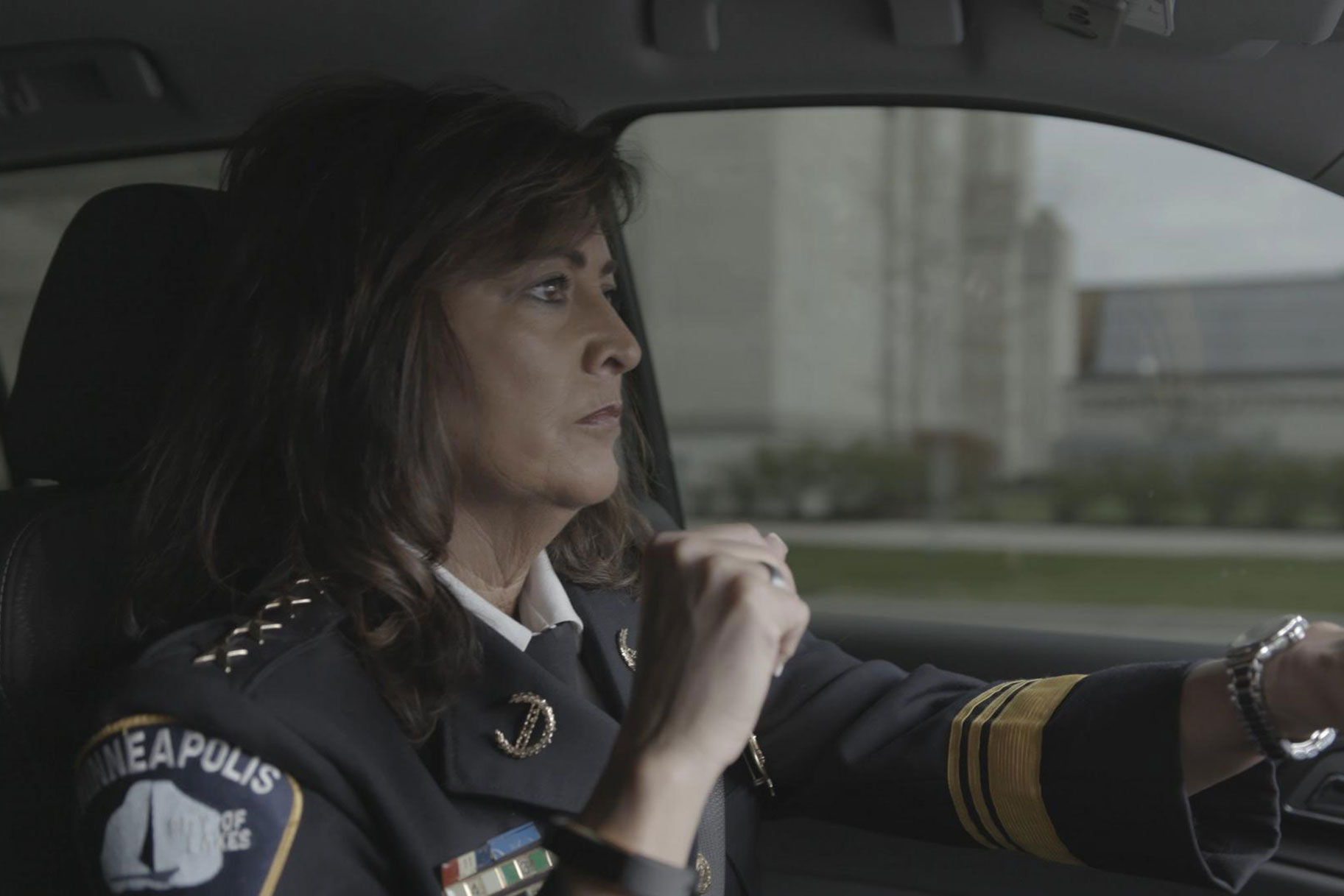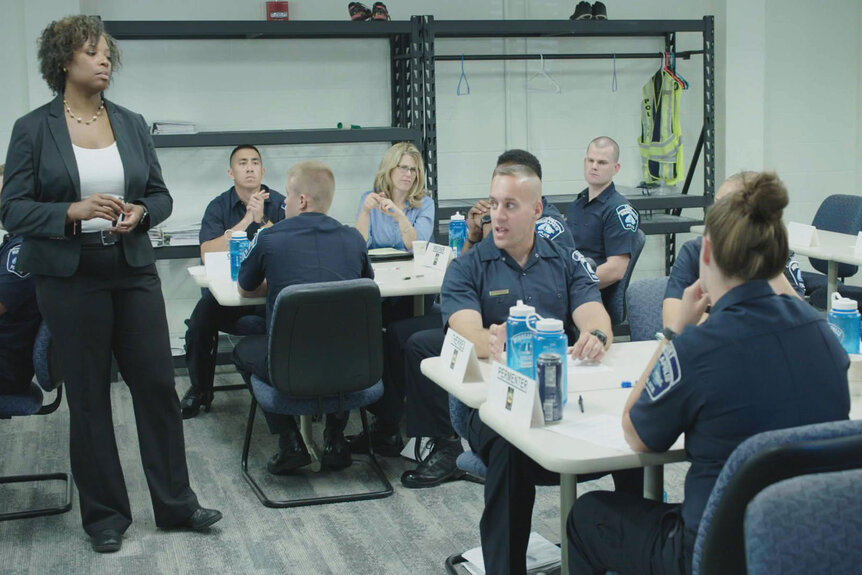Create a free profile to get unlimited access to exclusive videos, breaking news, sweepstakes, and more!
‘Women In Blue’ Offers Glimpse Into One Police Force’s Struggles With Gender And Racial Bias
A new documentary from PBS follows women in the Minneapolis police force from 2017 through the reckoning brought on by George Floyd’s killing.

Amid the deep and widespread outrage over the killing of George Floyd last spring, fresh scrutiny fell on the Minneapolis police force — again. This time, as mass protests erupted after the brutal footage of Floyd’s death went global, the department’s seemingly consistent string of deadly police killings finally brought repercussions, as the officers involved were slapped with murder charges and the city council made moves to overhaul the department’s funding. Meanwhile, the reckoning over Floyd’s killing and its aftermath pushed Minneapolis police into an existential crisis. As many officers resigned and some defended the status quo as necessary for security, others in the male-dominated department who still believed in its mission began some deep soul searching.
A new documentary from PBS’s Independent Lens, “Women In Blue,” examines the MPD from 2017 through the aftermath of Floyd’s killing, as its officers deal with persistent racial bias and gender equity issues across the force. The film follows four women working within the department — from its first female leader, former Chief Janée Harteau, as she sets out to advance women in the department’s ranks while changing its culture, to Alice White, a Black officer and Twin Cities native who moves up the department’s ranks. The variety of roles women take on within Harteau’s department, from patrolling the streets to heading internal affairs, are also highlighted in Deirdre Fishel’s film.
In 2017, out of the 850 officers in the MPD’s ranks, six were Black women. The differences in how men and women officers police, and how Black officers tend to interact with communities, get a close look in “Women in Blue.” As a part of procedural justice and implicit bias training programs implemented by Harteau, the department’s officers attended sessions on maintaining professionalism when dealing with tense situations and focusing on voice, neutrality, respect, and trustworthiness while responding to calls. In the film, White is shown speaking to a group of mostly male and predominantly white officers as part of the program.
“The challenge is to treat everyone involved in that call neutrally, and not have any pre-disposed thoughts or predictions about that particular situation in order to be neutral,” White tells the group. “I’m going to be honest — we interact with people that are murderers and rapists. It’s sometimes hard to show respect to someone like that. I had to switch this in my mind: ‘As long as you’re being professional, you’re going to look respectful.’”
These programs, which Harteau introduced in 2015, came just after an ACLU study was released showing that Minneapolis police arrested Black people and Native Americans at rates nearly nine times higher than white people. At this point, President Obama had also signed an executive order established a policing task force after the 2014 killing of Michael Brown in Ferguson, Missouri, which had spawned mass protests and ignited the Black Lives Matter movement. His administration had also started investigating police departments for practices that violated constitutional or federal rights.
But before any of this, the MPD had already been plagued with scandals. Police-involved killings and incidents of racist language by officers made headlines mostly locally, but the November 2015 killing of Jamar Clark by an MPD officer responding after a tussle at a birthday party put national attention on the city’s police. Weeks of protests and an 18-day occupation outside a north side precinct followed Clark's death. Then in 2018, Thurman Blevins was shot dead in the back while being chased by police and yelling "please don’t shoot me,” before he was killed, and video captured by body camera went viral. Officers involved in the killings of these young Black men did not face charges.
In May, Floyd, a father who was working as a truck driver and security guard before Minnesota shut down restaurants as part of a stay-at-home order, was accused of trying to buy cigarettes with a counterfeit $20 bill. He was killed while pinned, handcuffed and lying face-down, by Officer Derek Chauvin for at least eight minutes and 15 seconds as three other officers assisted or controlled onlookers, who caught it on video. This was, for many, the final straw. Calls for defunding the MPD grew as protests against police violence erupted globally.
For White, viewing the video of Floyd’s death was harrowing. She cried uncontrollably after watching the footage, she says in the film. But her strong family network and resolve to be the type of officer that she wished she’d encountered in her youth led to her decision to remain on the force. And that type of officer, she says, uses a different skill set.
"I'm not saying that all men police aggressively or in a manner that is unprofessional and bad," White told NPR’s Terry Gross in a recent interview. "But I am going to say women typically aren't policing in a manner that causes them to use ... their physical muscle. They're policing in a manner that they use their brain muscle."
This approach is consistent with Harteau’s plan during her tenure for reforming the department through accountability, transparency and respect. But as the film shows, she was pummeled with scandal upon scandal during her time as chief, which was cut short in 2017 after the killing by an officer of Justine Ruszczyk Damond, a white Australian-American woman who had called 911 to report a possible rape. MPD officer Mohamed Noor, who shot her in the abdomen from inside his patrol car, was charged with third-degree murder and manslaughter; earlier this month, his conviction was upheld by an appeals court and he will continue his 12.5-year sentence. In 2017, the fallout from Damond's killing was massive, and Harteau was swiftly asked to resign. She was replaced by Assistant Chief Medaria Arradondo, who became the city’s first Black police chief. But ripple effects emerged after Harteau’s departure.
“For many of these women, it was really hard after the first female chief resigned because they’d had a little bit of a taste of what it would feel like to be able to have influence and be empowered, and it felt like a real backslide,” Fishel told NPR.
Under Arradondo, the focus on gender equity diminished. One by one, as “Women in Blue” shows, female officers began to walk out the door. In 2018, Catherine Johnson, a precinct inspector who had reached the department’s upper echelons, left after 20 years. Melissa Chiodo, the chief of Internal Affairs, left Minneapolis to become chief of police in a nearby suburb in 2019. And scenes with rookie officer Erin Grabosky, in which the deep strain between the police and community is on full display and where she discusses the difficulty of working in a system run and populated by men, feel prescient about the future of women officers in Minneapolis.
White, meanwhile, remains steadfastly determined. After 17 years, she was promoted to sergeant in the city’s 4th precinct, which has the highest violent crime rate in Minneapolis. She’s now been in that leadership role for more than three years. In the film, she speaks to her daughter about the stigma she faces as a Black woman officer, and later, the killing of Floyd. Both discuss their feeling about her decision to continue as a police officer in such a complicated and dark time.
“I’m glad you’re a sergeant, teaching those group of cops, so hopefully with they become sergeants, they’re like you,” White’s daughter tells her. “And the next ones, and the next ones, so hopefully it just clears out the bad ones.”
On Friday, it was announced that Minneapolis will hire dozens of additional police officers after the city council agreed to release $6.4 million to the department. The money is coming from a fund created after Floyd’s death meant to increase police accountability and transparency. The council approved the funding without any discussion, according to the Star-Tribune.
Chauvin’s case, in which he is charged with second-degree unintentional murder and second-degree manslaughter, is set to go to trial in March. The other officers involved in Floyd's death will go to trial this summer.
Since 2000, as has been meticulously outlined in a new Star-Tribune database, police in Minneapolis have been involved in the deaths of 202 individuals.


























